An iron chain of length L lies on a rough table. The coefficient of friction between the chain and the table is . What maximum fraction of the chain can hang from the edge of the table?
1.
2.
3.
4.
A fire man of mass 60 kg slides down a pole. He is pressing the pole with a force of 600 N. The coefficient of friction between the hands and the pole is 0.5 . With what acceleration will the fire man slide down? (Take g = 10 )
1. 10
2. 5
3. 2.5
4. 1
A heavy block of mass M is slowly placed on a conveyor belt moving with
speed v. The coefficient of friction between the block and the belt is . Through what distance will the block slide on the belt?
1.
2.
3.
4.
The minimum acceleration that must be imparted to the cart in the fig. so that
the block A will not fall (given ia the coefficient of friction between the surfaces of block and cart) is given by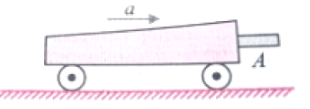
1.
2.
3.
4.
A block moves down a smooth inclined plane of inclination is . Its velocity on
reaching the bottom is . If it slides down a rough inclined plane of same inclination, its velocity on reaching the bottom is v/n, where n Is a number greater than zero. The coefficient of friction is given by
(1)
(2)
(3)
(4)
Minimum force required to pull the lower block (Take g = 10 )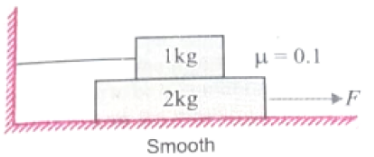
1. 1 N
2. 5 N
3. 7 N
4. 1O N
Two block of masses and are connected with a string passing over a pulley as shown in fig. The block lies on a horizontal surface. The coefficient of friction between the block and the horizontal surface is . The system accelerated. What additional mass m should be placed on the block so that the system does not accelerate?
1.
2.
3.
4.
Blocks A and B in the fig. are connected by a bar of negligible weight. If
=170 kg and the = 0.2 and = 0.4 where and are the coefficients of limiting friction between blocks and plane, calculate the force on the bar (g =)
1. 150 N
2. 75 N
3. 200 N
4. 250 N
A piece of wire is bent in the shape of a parabola y = (y-axis vertical) with a
bead of mass m on it. The bead can slide on the wire without friction. It stays at the lowest point of the parabola when the wire is at rest. The wire is now accelerated parallel to the x-axis with a constant acceleration a. The distance of the new equilibrium position of the bead, where the bead can stay at rest with respect to the wire, from the y-axis is
1.
2.
3.
4.
1.
2.
3.
4.
Two blocks A and B each of mass 1 kg are placed on a smooth horizontal surfaces. Two horizontal forces 5 N and 10 N are applied on the block A and B respectively as shown in fig. The block A does not slide on block B. Then the normal reaction acting between the two blocks is
1. 5 N
2.
3.
4. 15 N
Three block of masses m, M and M’ are arranged as shown in fig. The surfaces are frictionless, pulley and strings are ideal. The mass M’ of the hanging block which will prevent the smaller block (m) from slipping over the wedge will be
1.
2.
3.
4.
A block of mass m is on an inclined plane of angle . The coefficient of friction between the block and the plane is and tan > . The block is held stationary by applying a force P parallel to the plane. The direction of force pointing up the plane is taken to be positive. As P is varied from = mg to = mg , the frictional force f versus P graph will look like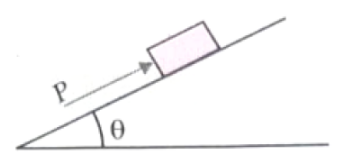
1. 
2. 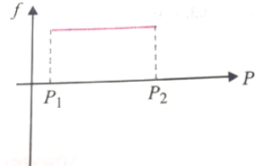
3. 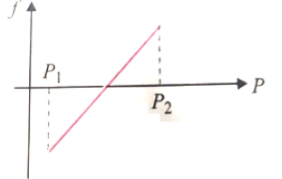
4. 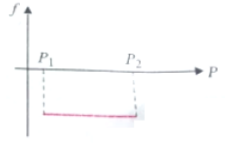

An insect crawls up a hemispherical surface very slowly, Fig, The coefficient of friction between the insect and the surface is 1/3. If the line joining the center of the hemispherical surface to the insect makes an angle ï with the vertical, the max. possible value of is given by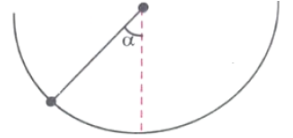
1. Cot = 3
2. sec = 3
3. cosec = 3
4. None
A block of mass m slides in an inclined right angled trough as shown in fig. If
coefficient of kinetic friction between block and material composing the trough is , find the acceleration of the block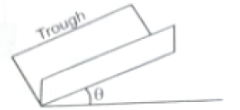
1.
2.
3.
4.
Find the accelerations , , of the three blocks C, B, A when a horizontal force of 10 N is applied on C, fig, Masses of A, B, C are 2 kg, 5 kg and 8 kg respectively, Coefficient of friction between two blocks is 0.2 and horizontal table is smooth.
(1) 3 , ,
(2) 4 , ,
(3) 5 , ,
(4) None of the above
What is the maximum value of the force F such that the block shown in the
arrangement, does not move? 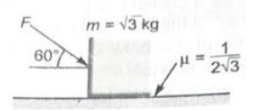
1. 20 N
2. 1O N
3. 12 N
4. 15 N
A horizontal force of 10 N is necessary to just hold a block stationary against a
wall. The coefficient of friction between the block and the wall is 0.2. The weight
of the block is 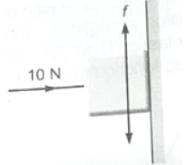
1. 20 N
2. 50 N
3. 1OO N
4. 2 N